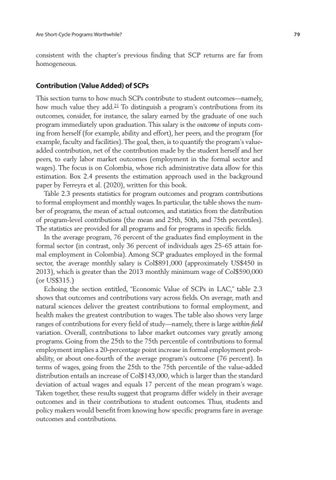Are Short-Cycle Programs Worthwhile?
consistent with the chapter’s previous finding that SCP returns are far from homogeneous.
Contribution (Value Added) of SCPs This section turns to how much SCPs contribute to student outcomes—namely, how much value they add.21 To distinguish a program’s contributions from its outcomes, consider, for instance, the salary earned by the graduate of one such program immediately upon graduation. This salary is the outcome of inputs coming from herself (for example, ability and effort), her peers, and the program (for example, faculty and facilities). The goal, then, is to quantify the program’s valueadded contribution, net of the contribution made by the student herself and her peers, to early labor market outcomes (employment in the formal sector and wages). The focus is on Colombia, whose rich administrative data allow for this estimation. Box 2.4 presents the estimation approach used in the background paper by Ferreyra et al. (2020), written for this book. Table 2.3 presents statistics for program outcomes and program contributions to formal employment and monthly wages. In particular, the table shows the number of programs, the mean of actual outcomes, and statistics from the distribution of program-level contributions (the mean and 25th, 50th, and 75th percentiles). The statistics are provided for all programs and for programs in specific fields. In the average program, 76 percent of the graduates find employment in the formal sector (in contrast, only 36 percent of individuals ages 25–65 attain formal employment in Colombia). Among SCP graduates employed in the formal sector, the average monthly salary is Col$891,000 (approximately US$450 in 2013), which is greater than the 2013 monthly minimum wage of Col$590,000 (or US$315.) Echoing the section entitled, “Economic Value of SCPs in LAC,” table 2.3 shows that outcomes and contributions vary across fields. On average, math and natural sciences deliver the greatest contributions to formal employment, and health makes the greatest contribution to wages. The table also shows very large ranges of contributions for every field of study—namely, there is large within-field variation. Overall, contributions to labor market outcomes vary greatly among programs. Going from the 25th to the 75th percentile of contributions to formal employment implies a 20-percentage point increase in formal employment probability, or about one-fourth of the average program’s outcome (76 percent). In terms of wages, going from the 25th to the 75th percentile of the value-added distribution entails an increase of Col$143,000, which is larger than the standard deviation of actual wages and equals 17 percent of the mean program’s wage. Taken together, these results suggest that programs differ widely in their average outcomes and in their contributions to student outcomes. Thus, students and policy makers would benefit from knowing how specific programs fare in average outcomes and contributions.
79

